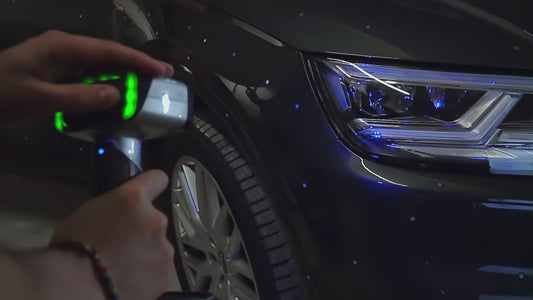Table of Contents
Whether you’re looking to reverse engineer products, ensure parts fit an assembly, or simply digitizing a model, choosing the right tool for the job is important. In this guidebook we’ll delve deeper into the technology and specifications so you know how to select the right scanner for your application!
1 - How do 3D scanners work?
2 - What are the differences between Laser and Structured Light scanners?
3 - Why should we choose: a desktop or handheld scanner?
Pt. 2
4 - What specifications should I look for when selecting a 3D scanner
5 - Some 3D Scanning Uses
How do 3D scanners work?
3D scanners are optical measurement systems that capture data from physical objects, subjects, or environments, and then convert it into an accurate digital model.
The captured data consists of an object’s shape, texture, surface, and position within a defined visual field, which is processed into an open 3D point cloud and then a closed solid mesh. Mesh data is often imported to 3D graphics, CAD modeling, or inspection software for analysis, editing, and manipulation to suit a vast range of applications. The use of 3D scanning can replace traditional workflows such as gathering measurements by hand and creating a mold or plaster of a model to get its 3D shape.
Many different 3D scanning technologies exist but laser triangulation and structured light projection are the two dominant ones that suit a wide range of applications. Both shine their light source at an object and use cameras as sensors to create 3D point clouds. Through the process of triangulation, these open points in 3D space are closed to form a mesh model.
Laser and structured light projection determine the distance from an object to a set of cameras by measuring how the object deforms, distorts, and reflects the trajectory of the light.
Whether you’re looking to reverse engineer products, ensure parts fit an assembly, or simply digitizing a part, choosing the right tool for the job is important. In this guidebook we’ll delve deeper into the technology and specifications so you know how to select the right scanner for your application!
What are the differences between Laser and Structured Light Scanners?
The main advantage of laser scanning is that it is less sensitive to environmental light and performs much better than structured light for reflective or dark surfaces. Laser scanners shine a laser line onto a surface and create a line of points where the laser hits the surface. The distance between points can be incredibly small, hence very high resolution, but as you can imagine, scanning one line across the surface of the object is incredibly inefficient. To compensate, most laser scanners are handheld and utilize many long laser lines so that it becomes more efficient at scanning a large surface area found on automobiles, aircrafts, boats, and ships. All laser scanners require reflective markers to be placed on the object or around it which help the alignment of point data for an accurate 3D model. Laser scanning technology is the dominant force for metrology because they are able to provide very high resolution and accurate scans with some providing up to 0.05 mm point distances and 0.05 mm/m volumetric accuracy. These powerful scanners usually start around $20,000 and can cost up to $60,000 for the most efficient units.
Structured light 3D scanners use a projector to display stripe or pixelated light patterns onto the surface of an object which are tracked simultaneously by one or multiple cameras. This technology can capture a large area in seconds, and guarantees great accuracy and resolution, though not as high as laser scanning technology.
A strong benefit of structured light is it can use a few different alignment methods - features, markers, or color - while laser scanning requires markers for data alignment. SLP (Structured Light projection) can collect many unique features or markers in one shot and use this data for aligning consequent shots together to create an accurate and dense point cloud. With the addition of a color camera, SLP scanners can also capture 24-bit color and use this information for aligning shots together - which really helps in capturing artwork or flat surfaces with a unique color profile.
Infrared, white, or blue LED light sources can be used with SLP and these are not hazardous to the human eyesight, so this technology can be used to scan faces. Structured light scanners work very well as a stationary scanner and as a handheld scanner to cover any object size. However, it is sensitive to environment light conditions and does not perform well on very dark parts that absorb light or reflective parts that scatter light.
What would we choose: a desktop or handheld scanner?
Desktop scanners project several patterns onto the face of an object and snap a few images to create the 3D point cloud. Handheld devices project and capture images instantaneously and the user can scan the object from multiple angles to capture an accurate 3D model quickly.
Why would we choose a desktop scanner?
Desktop/ stationary scanners are much better at capturing parts in high resolution and accuracy especially for small parts (0.5 in to 2 in)
Placing an object on a turntable and scanning is much simpler than using a handheld system and moving around the object.
However it is hard to capture all surfaces of an object as there will be shadows that form which the cameras cannot see. This requires the user to find several positions, and angles to focus on the object to capture everything
Desktop scanners are more likely to utilize structured light projection technology and can achieve better resolution and accuracy than their handheld scanner counterparts.
Why would we choose a handheld scanner?
Handheld scanners continuously scan an object so they are much better at scanning wider surfaces and larger parts. Most handheld scanners have a large capture area and capture 500,000+ points per second at 15+ frames per second.
Compared to desktop scanners, handheld scanners are much more portable and versatile, so they are easier to use for remote projects.
It is easier to capture deep pockets or cavities in an object with a handheld scanner than with a desktop scanner
Laser handheld scanners can achieve better resolution, accuracy, and scan significantly larger parts than laser desktop scanners
Handheld scanners that use structured light projection can capture objects very rapidly~ however, the resolution and accuracy often falls short compared to desktop SLP scanners






